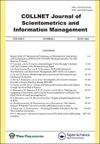Relationship between number of downloads and three journal-based metrics of 11 subject categories among 1575 Springer Nature journals
IF 0.8
Q2 INFORMATION SCIENCE & LIBRARY SCIENCE
COLLNET Journal of Scientometrics and Information Management
Pub Date : 2022-07-03
DOI:10.1080/09737766.2022.2117667
引用次数: 0
Abstract
The number of downloads (NOD) is a measure of the number of accesses to (or downloads of) published articles and a subset of altmetrics. In this study, we assessed the correlation between the journal impact factor (JIF) and NOD for 11 subject categories on Springer Nature’s Springerlink to determine if there were differences in NOD among Google Scholar, Scopus (CiteScore) and Clarivate’s JIF across these subject categories, and attempted to predict NOD using JIF. From a total of 1575 journals, 1155 (73.3%) were grouped under JIF, 275 (17.5%) under CiteScore, and 145 (9.2%) under Google Scholar. Among the 1155 JIF journals, 1007 (87.2%) were subscription or hybrid journals while 148 (12.8%) were open access journals. Except for “environment”, there was a significant positive correlation between NOD and JIF for all remaining subject categories. Correlations changed slightly even after open access was removed from all categories. The Kruskal Wallis test showed significant differences in median NOD for journals with a CiteScore, Google Scholar and JIF, and this was fortified by a posthoc test (Conover p-values without adjustment). After aggregating the data of all subject categories into two sub-categories (NOD and JIF) of the 1155 journals with a JIF, finally, Adaptive Boosting performed best among eight machine learning models to predict NOD using JIF (RMSE = 84139.1; R2 = 0.9669). This research extends researchers’ understanding of the relationship between altmetrics and citations with journal metrics that are typically obtained using citations. Knowledge of a JIF can predict NOD with some permissible error.1575份《施普林格自然》杂志中11个主题类别的下载量与三项基于期刊的指标之间的关系
下载次数(NOD)是访问(或下载)已发布文章的次数和替代指标子集的度量。在本研究中,我们评估了谷歌Nature’s Springerlink上11个学科类别的期刊影响因子(JIF)与NOD之间的相关性,以确定谷歌Scholar、Scopus (CiteScore)和Clarivate的JIF在这些学科类别中是否存在NOD差异,并试图使用JIF预测NOD。在1575种期刊中,JIF收录了1155种(73.3%),CiteScore收录了275种(17.5%),谷歌Scholar收录了145种(9.2%)。在JIF收录的1155种期刊中,订阅或混合期刊1007种(87.2%),开放获取期刊148种(12.8%)。除“环境”外,其余所有主题类别的NOD与JIF均呈显著正相关。即使从所有类别中删除开放获取,相关性也略有变化。Kruskal Wallis检验显示,CiteScore、谷歌Scholar和JIF期刊的NOD中位数存在显著差异,并通过后检验(未经调整的Conover p值)进一步证实了这一点。在将所有学科类别的数据汇总到具有JIF的1155种期刊的两个子类别(NOD和JIF)后,最终,Adaptive Boosting在使用JIF预测NOD的8种机器学习模型中表现最好(RMSE = 84139.1;R2 = 0.9669)。这项研究扩展了研究人员对替代指标和引文之间关系的理解,期刊指标通常是通过引文获得的。对JIF的了解可以在允许的误差范围内预测NOD。
本文章由计算机程序翻译,如有差异,请以英文原文为准。
求助全文
约1分钟内获得全文
求助全文
来源期刊

COLLNET Journal of Scientometrics and Information Management
INFORMATION SCIENCE & LIBRARY SCIENCE-
自引率
0.00%
发文量
11
 求助内容:
求助内容: 应助结果提醒方式:
应助结果提醒方式:


